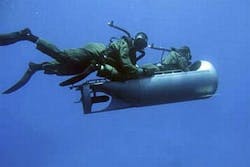DARPA asks Honeywell to develop common testing for advanced MEMS-based inertial navigation
ARLINGTON, Va., 7 Feb. 2012.Navigation and guidance researchers at the U.S. Defense Advanced Research Projects Agency (DARPA) in Arlington, Va., are asking test and measurement experts at the Honeywell Aerospace Microelectronics & Precision Sensors segment in Plymouth, Minn., develop a universal testing platform for advanced miniature gyroscopes under development for smart munitions, ships, vehicles, aircraft, infantry soldiers, and ocean divers.
Officials of the DARPA Microsystems Technology Office (MTO) are awarding a sole-source contract to Honeywell for a Platform for Acquisition, Logging, and Analysis of Devices for Inertial Navigation (PALADIN) under the Micro Rate Integrating Gyroscope (MRIG) program.
DARPA officials say Honeywell is the only available contractor available with the expertise to build such test methodology for the advanced inertial navigation systems under development today using micro-electro-mechanical systems (MEMS) technology. A contract amount has yet to be negotiated.
The DARPA MRIG program, begun last year, seeks to develop a micro-scale gyro for single-chip inertial navigation and guidance systems that operate independently of the satellite-based global positioning system (GPS) or any other external signals for uncompromised navigation and guidance for weapons platforms such as missiles, ships, and aircraft, as well as for individuals like infantry soldiers and ocean divers.
A vibrating-structure gyroscope operates on the principle that a vibrating object tends to keep vibrating in the same plane as its support is rotated. It is less complex and more affordable to design and build than is a conventional rotating gyroscope of similar accuracy.
Contractors working on the DARPA MRIG program include Honeywell, the Northrop Grumman Corp. Electronic Systems segment in Woodland Hills, Calif., the Charles Stark Draper Laboratory in Cambridge, Mass., the Georgia Institute of Technology (Georgia Tech) in Atlanta, and the Systron Donner Inertial segment of Custom Sensors & Technologies (CST) in Concord, Calif.
The DARPA MRIG program seeks to create a vibratory gyroscope that measures the angle of rotation in a way that the gyros can extend their dynamic range, as well as eliminate the need for integrating angular rate information. The overall goal is to eliminate an accumulation of errors due to numerical and electronic integration. Rate integrating gyroscope technology has never been demonstrated on the microscale level.
Under the current effort, Honeywell scientists will develop the PALADIN platform to allow rapid early stage testing of MRIG prototypes. Evaluation of these kinds of prototypes typically is a boutique process, where a customized setup is necessary for each device, which is laborious and expensive.
The Honeywell PALADIN effort builds on their prior work on the Tactical Underwater Navigation Systems (TUNS) program, in which company engineers demonstrated the Agile Navigation & Guidance Integrated Electronics (ANGIE) embedded computer that hosts navigation and guidance applications with custom electronics.
The TUNS program focused on underwater navigation for individual divers, for whom GPS navigation alone is unsuitable because its signal from overhead satellites is attenuated by the water. The TUNS program sought to integrate a GPS receiver, inertial measurement unit, solid-state magnetometer, pressure sensor and a multi-axis Doppler velocity sensor for underwater navigation, surveying, and mapping.
For the PALADIN effort, Honeywell experts will capitalize on hardware and software they developed for the TUNS program, which they will modify realize an experimental testing platform capable of analog and digital data logging, real-time analysis of inertial sensors, and deployable in harsh-temperature and vibrational environments.
For more information contact Honeywell Aerospace Microelectronics & Precision Sensors online at www.honeywellmps.com, or the DARPA Microsystems Technology Office at www.darpa.mil/Our_Work/MTO.
